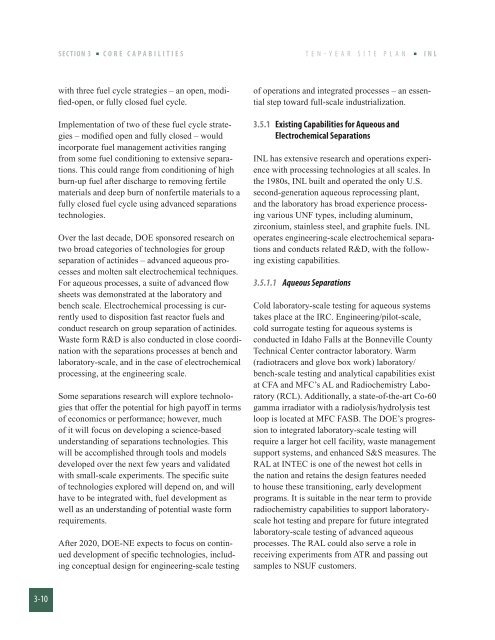2013-2022 TEN-YEAR SITE PLAN - Idaho National Laboratory
2013-2022 TEN-YEAR SITE PLAN - Idaho National Laboratory
2013-2022 TEN-YEAR SITE PLAN - Idaho National Laboratory
You also want an ePaper? Increase the reach of your titles
YUMPU automatically turns print PDFs into web optimized ePapers that Google loves.
3-10<br />
SECTION 3 CORE CAPABILITIES<br />
with three fuel cycle strategies – an open, modified-open,<br />
or fully closed fuel cycle.<br />
Implementation of two of these fuel cycle strategies<br />
– modified open and fully closed – would<br />
incorporate fuel management activities ranging<br />
from some fuel conditioning to extensive separations.<br />
This could range from conditioning of high<br />
burn-up fuel after discharge to removing fertile<br />
materials and deep burn of nonfertile materials to a<br />
fully closed fuel cycle using advanced separations<br />
technologies.<br />
Over the last decade, DOE sponsored research on<br />
two broad categories of technologies for group<br />
separation of actinides – advanced aqueous processes<br />
and molten salt electrochemical techniques.<br />
For aqueous processes, a suite of advanced flow<br />
sheets was demonstrated at the laboratory and<br />
bench scale. Electrochemical processing is currently<br />
used to disposition fast reactor fuels and<br />
conduct research on group separation of actinides.<br />
Waste form R&D is also conducted in close coordination<br />
with the separations processes at bench and<br />
laboratory-scale, and in the case of electrochemical<br />
processing, at the engineering scale.<br />
Some separations research will explore technologies<br />
that offer the potential for high payoff in terms<br />
of economics or performance; however, much<br />
of it will focus on developing a science-based<br />
understanding of separations technologies. This<br />
will be accomplished through tools and models<br />
developed over the next few years and validated<br />
with small-scale experiments. The specific suite<br />
of technologies explored will depend on, and will<br />
have to be integrated with, fuel development as<br />
well as an understanding of potential waste form<br />
requirements.<br />
After 2020, DOE-NE expects to focus on continued<br />
development of specific technologies, including<br />
conceptual design for engineering-scale testing<br />
T E N - Y E A R S I T E P L A N INL<br />
of operations and integrated processes – an essential<br />
step toward full-scale industrialization.<br />
3.5.1 Existing Capabilities for Aqueous and<br />
Electrochemical Separations<br />
INL has extensive research and operations experience<br />
with processing technologies at all scales. In<br />
the 1980s, INL built and operated the only U.S.<br />
second-generation aqueous reprocessing plant,<br />
and the laboratory has broad experience processing<br />
various UNF types, including aluminum,<br />
zirconium, stainless steel, and graphite fuels. INL<br />
operates engineering-scale electrochemical separations<br />
and conducts related R&D, with the following<br />
existing capabilities.<br />
3.5.1.1 Aqueous Separations<br />
Cold laboratory-scale testing for aqueous systems<br />
takes place at the IRC. Engineering/pilot-scale,<br />
cold surrogate testing for aqueous systems is<br />
conducted in <strong>Idaho</strong> Falls at the Bonneville County<br />
Technical Center contractor laboratory. Warm<br />
(radiotracers and glove box work) laboratory/<br />
bench-scale testing and analytical capabilities exist<br />
at CFA and MFC’s AL and Radiochemistry <strong>Laboratory</strong><br />
(RCL). Additionally, a state-of-the-art Co-60<br />
gamma irradiator with a radiolysis/hydrolysis test<br />
loop is located at MFC FASB. The DOE’s progression<br />
to integrated laboratory-scale testing will<br />
require a larger hot cell facility, waste management<br />
support systems, and enhanced S&S measures. The<br />
RAL at INTEC is one of the newest hot cells in<br />
the nation and retains the design features needed<br />
to house these transitioning, early development<br />
programs. It is suitable in the near term to provide<br />
radiochemistry capabilities to support laboratoryscale<br />
hot testing and prepare for future integrated<br />
laboratory-scale testing of advanced aqueous<br />
processes. The RAL could also serve a role in<br />
receiving experiments from ATR and passing out<br />
samples to NSUF customers.

















